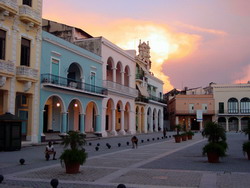Old Havana, a vital focus of Cuban Culture
- Submitted by: admin
- Travel and Tourism
- Arts and Culture
- culture an traditions
- Culture and Traditions
- Dance
- Education
- Entertainment
- Havana
- History
- Music
- national
- Paint and Sculpture
- personalities
- Society
- Theater
- Personalities
- Politics and Government
- 12 / 25 / 2009

Among these restored works we have the former stores San Jose, building dating from 1885, which became a Cultural Centre as well as the rescue of the railway line that runs along the bay recently discovered by archaeologists on the Port Avenue, near the Paula Promenade.
The train is one of the nearly 40 rescued from old mills and sugar cane fields, which will be exhibited at the railway museum. Near the end of the year, the first large-scale planetarium, a collaboration between Cuba and Japan, which donated
nearly half a million dollars in equipment and accessories opened to the public.
Located in the Old Square, it will have telescopes, an astronomical library with computer graphics, interactive games, a qualified staff of astronomers and physicists to operate the equipment and a projector capable of capturing 6.500 stars.
Delegations from Germany, Holland, Belgium, Poland, Italy and France were present during 2009, in Old Havana, with proposals for visual arts, cinema, theatre, music, dance, literature and photography, along with other Natural Science and Astronomy.
France was the first country that came with the exhibition Images of Louvre, six centuries of European painting, composed of 101 photographic reproductions of works of the Paris museum, natural size, including Leonardo da Vinci’s Mona Lisa.
Exhibited outdoors at the bars of the Castle of the Royal Force with explanatory panels on the period of creation of each piece, the collection brought together most of the artistic movements and schools of French, Italian, Spanish, and Britain painting.
The Museum of Contemporary Art M HKA in Antwerp, Belgium, brought the exhibition Después del Arte, with more than 100 works made by 35 artists belonging to the funds of that institution.
Works by Chilean Alfredo Jaar, American Cindy Sherman, Gordon Matta-Clark, Spanish Antonio Muntadas, and Russian Sergei Bratkov excel in the exhibition.
Belgians plastic arts have a permanent place in the Havana Historic Centre at La Vitrina de Valonia, where comic fans—intangible heritage of that nation— receive classes and advices on this technique. It also has an extensive collection of pieces donated by the Belgian Embassy.
A replica of the carnivals Blancs Moussis and Gilles, Belgian villages of Stavelot and Binche, by the Cuban group Giganterías could be seen for the first time.
A tribute to the Italian philosopher and astronomer Galileo Galilei, on the 400th anniversary of the invention of the telescope (1609-2009), called everybody’s attention in the 12th week of Italian culture.
The centenary of the first publication of the Futurist Manifesto, a movement of artistic and literary avant-gardes of the 20th century was remembered with a panel chaired by the Cuban essayist and researcher Graziella Pogolotti.
Venice panoramic photography exhibition by Mimmo Fabrizi, a concert by the National Lyric Theatre with Italian oboist Gianfranco Bortolato of the Opera of Rome and a recital of Neapolitan songs of the 19th and 20th centuries, met the expectations of visitors attracted to the Italian art.
The legacy of the German naturalist Alexander von Humboldt in Cuba and his contributions to botany and zoology enriched the first German days, dedicated to World Environment Day, June 6th. A cartographic folding on the presence of that European nation was introduced by Cuban writer and ethnologist Miguel Barnet, which included details of the personalities who came or lived in Cuba as well as pictures of the plaque commemorating the visit of Albert Einstein to our capital in 1930.
The Old Havana became venue of the International Dance Festival in Urban Landscapes, which brought together dancers of 15 countries from Latin America and Europe.
The project Rutas y Andares is a privilege for families during the summer. It encourages the approach to museums, houses and heritage sites. The 9th edition gathered 13.200 visitors, according to figures from the Office of the Historian of the City.
The House of the Father of the Americas, Benito Juárez, led the tributes for the bicentenary of the start of the independence struggles in the continent with an artistic gala celebrating the Grito de Dolores on September 15th, eve of the commemoration in Mexico.
Lectures on the presence of the Yucatan in Cuba and a numismatic exhibition of coins belonging to the War of Independence and the Revolution were included in the tribute.
The role of tobacco emigrants in Tampa, United States, in the creation of the Cuban Revolutionary Party created by the independence leader José Martí was discussed at the International Symposium Havana-Habanos, organized every two years by the
Museum of Tobacco.
The Old Havana maintained its cultural effervescence in 2009, not to mention the ritual of the three turns to the Ceiba tree located in El Templete, which recalls the place it was founded in 1519.
Source: PL and Cubasí
Comments